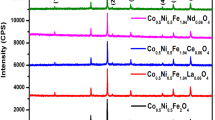Abstract
An investigation of the effects of the iron defect k in LiZnTiMn ferrites using Mössbauer spectroscopy and ferromagnetic resonance techniques was carried out in single-phased samples. Results show that the isomer shifts have values corresponding to a compound with either low-spin Fe(II), low-spin Fe(III), or high-spin Fe(III). On the other hand, the Lande factor and the ferromagnetic resonance linewidth disclosed that g is always very close to 2, being equal to 2.02 when k = 0.06. A minimum in ΔH was detected for this value of k. From these results, the possible presence of Fe2+ in the samples could be excluded, and it was concluded that the changes in ΔH are due to the variation of the Fe(III) contents in the tetrahedral and octahedral sites. The existence of the minimum in ΔH is due to a compensation point in the magnetocrystalline anisotropy.
Similar content being viewed by others
References
A. Iglesias, I.V. Guerasimenko, S. Díaz, and A. González Arias, Phys. Status Solidi A 221 (1993).
A. González Arias, A. Del Cueto, J.M. Muñoz, and C. De Francisco, Mater. Lett. 37, 187 (1998).
D.H. Ridgley, H. Lessoff, and J.D. Childress, J. Am. Ceram. Soc. 53, 6, 304 (1970).
C. Flores, A. González Arias, V. Raposo, L. Torres, J. Iñiguez, and C. De Francisco, J. Magn. Magn. Mater. 226–230, 1432–1434 (2001).
5. K. Deeppik, P. Sumitra, J.S. Baijal, K. Prom, and P. Chandra, J. Phys. C: Solid State Phys. 21, 6169 (1988).
K.S. Kulshreshtha, J. Magn. Magn. Mater. 53, 345 (1986).
A.A. Yousif, M.E. Elzain, S.A. Mazen, H. Sutherland, H. Abdala, and S.F. Masour, J. Phys.: Condens. Matter 6, 5717 (1994).
H.H. Wickman, Mössbauer Effects Methodology (Magnum Press, 1966), Vol. 2, p. 34.
ICC Standard No. 596, 5th ed. (International Electrotechnical Commission, Geneva, Switzerland, 1980).
U. Gonser, Mössbauer Spectroscopy (Springer-Verlag, Berlin and Heidelberg, Germany, New York, 1975), p. 69.
N.M. Artherton, Electron Spin Resonance, Theory and Practice (John Wiley, New York, 1994).
J.A. Weil, J.R. Bolton, and E. Wertz, Electron Spin Resonance, 2nd ed. (John Wiley, New York, 1994).
S. Jan, W. Gerhard, V. Jan, J.F. Dillon Jr., S. Weiss, J.C. Mallison, and S. Middelhoek, Magnetic Properties of Materials (McGraw-Hill, New York, 1971), p. 9.
W.P. Wolf, Phys. Rev. 108, 1152 (1957).
Author information
Authors and Affiliations
Corresponding author
Rights and permissions
About this article
Cite this article
Iglesias, A., Balmaseda, J. & Arias, A.G. Fe2+ Contents and Magnetocrystalline Anisotropy in Iron Defect LiZnTiMn Ferrites. Journal of Materials Research 17, 1702–1705 (2002). https://doi.org/10.1557/JMR.2002.0251
Received:
Accepted:
Published:
Issue Date:
DOI: https://doi.org/10.1557/JMR.2002.0251




